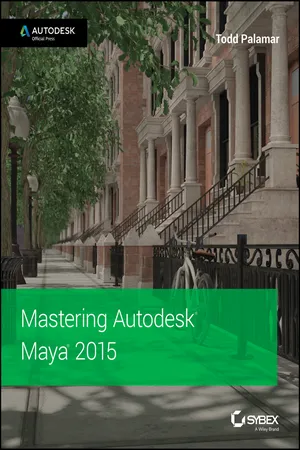
- English
- ePUB (mobile friendly)
- Available on iOS & Android
About this book
Expand your skills with complete Maya mastery
Mastering Autodesk Maya is the ultimate guide to the popular 3D animation software. Author Todd Palamar draws on his extensive professional animation experience to help readers take their Maya skills to the next level. Written for those who already know the basics of this enormous program, the book covers advanced topics and professional techniques for modeling, animation, texturing, and visual effects.
Fully updated to reflect Maya's latest features, the book takes a hands-on approach to instruction, providing readers with a diverse set of tutorials designed by real-world professionals to showcase 3D animation and visual techniques used in industry settings. Complete and comprehensive, the book makes an excellent desk reference for the working animator, and is an ideal resource for those seeking Maya certification. The unique combination of challenging material and practical instruction make this one-of-a-kind guide the ultimate Maya handbook. Topics include:
- Animation using inverse kinematics, keyframes, and deformers
- Hard surface and organic modeling
- Proper rigging techniques, and working with Maya Muscle
- Xgen, Paint Effects, and rendering with mental ray
- Texture mapping, compositing, nParticles, and more
- Virtual filmmaking and scene management
The most complex skills are useless if they can't be applied, so the book emphasizes the practical, day-to-day uses of each skill, and discusses which solutions best fit which scenario. For the computer animation professional seeking a more in-depth mastery of this popular animation program, Mastering Autodesk Maya is an excellent investment in the future of your career.
Frequently asked questions
- Essential is ideal for learners and professionals who enjoy exploring a wide range of subjects. Access the Essential Library with 800,000+ trusted titles and best-sellers across business, personal growth, and the humanities. Includes unlimited reading time and Standard Read Aloud voice.
- Complete: Perfect for advanced learners and researchers needing full, unrestricted access. Unlock 1.4M+ books across hundreds of subjects, including academic and specialized titles. The Complete Plan also includes advanced features like Premium Read Aloud and Research Assistant.
Please note we cannot support devices running on iOS 13 and Android 7 or earlier. Learn more about using the app.
Information
Chapter 1
Working in Autodesk Maya
- Understand transform and shape nodes
- Create a project
Creating and Editing Nodes

Table of contents
- Cover
- Title Page
- Copyright
- Publisher's Note
- Acknowledgments
- About the Author
- Introduction
- Chapter 1: Working in Autodesk Maya
- Chapter 2: Introduction to Animation
- Chapter 3: Hard-Surface Modeling
- Chapter 4: Organic Modeling
- Chapter 5: Rigging and Muscle Systems
- Chapter 6: Animation Techniques
- Chapter 7: Lighting with mental ray
- Chapter 8: mental ray Shading Techniques
- Chapter 9: Texture Mapping
- Chapter 10: Paint Effects
- Chapter 11: Rendering for Compositing
- Chapter 12: Introducing nParticles
- Chapter 13: Dynamic Effects
- Chapter 14: Hair and Clothing
- Chapter 15: Maya Fluids
- Chapter 16: Scene Management and Virtual Filmmaking
- Appendix A: The Bottom Line
- Appendix B: Autodesk Maya 2015 Certification
- End User License Agreement